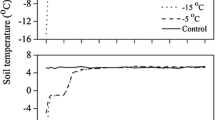Summary
In humid regions of the United States there is considerable interest in the use of late spring (April–June) soil NO −3 concentrations to estimate fertilizer N requirements. However, little information is available on the environmental factors that influence soil NO −3 concentrations in late winter/early spring. The influence of freeze-thaw treatments on N mineralization was studied on several central Iowa soils. The soils were subjected to temperatures of-20°C or 5°C for 1 week followed by 0–20 days of incubation at various temperatures. The release of soluble ninhydrin-reactive N, the N mineralization rate, and net N mineralization (mineral N flush) were observed. The freeze-thaw treatment resulted in a significant increase in the N mineralization rate and mineral N flush. The N mineralization rate in the freeze-thaw treated soils remained higher than in non-frozen soils for 3–6 days when thawed soils were incubated at 25°C and for up to 20 days in thawed soils incubated at 5°C. The freeze-thaw treatments resulted in a significant release of ninhydrin-reactive N. These values were closely correlated with the mineral N flush (r 2=0.84). The release of ninhydrin-reactive N was more closely correlated with biomass N (r 2=0.80) than total N (r 2=0.65). Our results suggest that freeze-thaw events in soil disrupt microbial tissues in a similar way to drying and re-wetting or chloroform fumigation. Thus the level of mineral N released was directly related to the soil microbial biomass. We conclude that net N mineralization following a spring thaw may provide a significant portion of the total NO −3 present in the soil profile.
Similar content being viewed by others
References
Allen SE, Grimshaw MH (1962) Effect of low temperature storage on the extractable nutrient ions in soils. J Sci Food Agric 13:535–539
Amato M, Ladd JN (1988) Assay for microbial biomass based on ninhydrin-reactive nitrogen extracts of fumigated soil. Soil Biol Biochem 20:107–114
Blackmer AM, Pottker D, Cerrato ME, Webb J (1989) Correlations between soil nitrate concentrations in late spring and corn yields in Iowa. J Prod Agric 2:103–109
Bremner JM, Breitenbeck GA (1983) A simple method for determination of ammonium in semimicro-Kjeldahl analysis of soils and plant materials using a block digester. Commun Soil Sci Plant Anal 14:905–913
Campbell CA, Biederbeck VO, Warder FG (1971) Influence of simulated spring conditions on the soil system: II. effect on soil nitrogen. Soil Sci Am Proc 35:480–483
Carter MR (1991) Ninhydrin reactive N released by the fumigation-extraction method as a measure of microbial biomass under field conditions. Soil Biol Biochem 23:139–143
Dorland S, Beauchamp EG (1991) Denitrification and ammonification at low soil temperatures. Can J Soil Sci 71:293–303
Elford CR, Shaw RH (1960) The climate of Iowa: II. Soil temperatures at Ames. Agriculture and Home Economics Experiment Station Special Report no. 24, Ames, Iowa, pp 3–36
Gasser JKR (1956) Use of deep-freezing in the preservation and preparation of fresh soil samples. Nature 181:1334–1335
Ivarson KC, Sowden FJ (1965) Effect of freezing on the free amino acid content in soil. Can J Soil Sci 46:115–120
Ivarson KC, Sowden FJ (1970) Effects of soil action and storage of soil at freezing temperatures on the free amino acids, free sugar and respiratory activity of soil. Can J Soil Sci 59:191–198
Jenkinson DS, Powlson DS (1976) Effects of biocidal treatments on metabolism: V. A method for measuring soil biomass. Soil Biol Biochem 8:209–213
Keeney DR (1982) Nitrogen availability indices. In: Page AL, Miller RH, Keeney DR (eds) Methods of soil analysis: Part 2. Am Soc Agron, Madison, Wisconsin, pp 711–733
Keeney DR, Nelson DW (1982) Nitrogen: Inorganic forms. In: Page AL, Miller RH, Keeney DR (eds) Methods of soil analysis: Part 2. Am Soc Agron, Madison, Wisconsin, pp 643–698
Kladivko JE, Keeney DR (1987) Soil nitrogen mineralization as affected by water and temperature interaction. Biol Fertil Soils 5:248–252
Mack AR (1963) Biological activity and mineralization of nitrogen in three soils as induced by freezing and drying. Can J Soil Sci 43:16–24
Magdoff FR (1991) Understanding the Magdoff pre-sidedress nitrate test for corn. J Prod Agric 4:297–305
Magdoff FR, Jokela WE, Fox RH, Griffin GF (1990) A soil test for nitrogen availability in the Northeastern U.S. Commun Soil Sci Plant Anal 21:1103–1115
Marumoto T, Anderson JPE, Domsch KH (1982) Mineralization of nutrients from microbial biomass. Soil Biol Biochem 14:469–475
Mazur P (1980) Limits to life at low temperatures and at reduced water contents and water activities. Origins Life 10:137–159
Moore S, Stein WH (1954) A modified ninhydrin reagent for the photometric determination of amino acid related compounds. J Biol Chem 211:907–913
Morely CR, Trofymow JA, Coleman DC, Cambardella C (1983) Effects of freeze-thaw stress on bacterial populations in soil microcosms. Microb Ecol 9:329–340
Nelson DW, Sommers LE (1982) Total carbon, organic carbon, and organic matter. In: Page AL, Miller RH, Keeney DR (eds) Methods of soil analysis: Part 2. Am Soc Agron, Madison, Wisconsin, pp 539–578
Ross DJ (1972) Effects of freezing and thawing of some grassland topsoils on oxygen uptakes and dehydrogenase activities. Soil Biol Biochem 4:115–117
Ross DJ, Tate KR, Cairns A, Meyrick KF (1980) Influence of freezing on soil microbial biomass as estimated by three biochemical procedures. Soil Biol Biochem 12:369–374
Skogland T, Lomeland S, Gokoyr J (1988) Respiratory burst after freezing and thawing of soil: Experiments with soil bacteria. Soil Biol Biochem 20:851–856
Soulides DA, Allison FE (1961) Effect of drying and freezing on carbon dioxide production, available mineral nutrients, and bacterial population. Soil Sci 91:294–298
Stanford G, Smith SJ (1982) Nitrogen mineralization potentials of soils. Soil Sci Am Proc 36:465–472
Stevenson FJ (1982) Humus chemistry. John Wiley and Sons, New York
Author information
Authors and Affiliations
Rights and permissions
About this article
Cite this article
DeLuca, T.H., Keeney, D.R. & McCarty, G.W. Effect of freeze-thaw events on mineralization of soil nitrogen. Biol Fertil Soils 14, 116–120 (1992). https://doi.org/10.1007/BF00336260
Received:
Issue Date:
DOI: https://doi.org/10.1007/BF00336260




